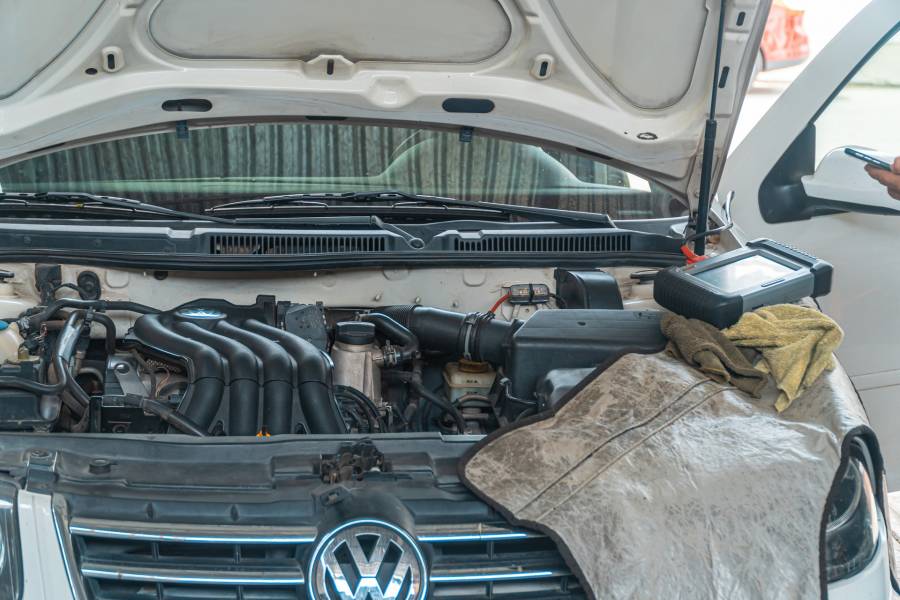Quick Navigation
If you’ve come across this post, the chances are that you’ve run into some car problem and you need help.
Owning a car means that now and then, you will be faced with some car issues. Most of these problems will be easy to solve if you are lucky.

Car dropping RPM while idling is one of those many issues. While this RPM drop is usually not a big issue, it needs to be addressed sooner than later.
For example, the car can sometimes shake back and forth when you step on the gas pedal.
In such a case, this RPM drop can cause great inconvenience in the future if you do not tackle it.
RPM Drop While Idling
RPM drop can happen as you sit in your idling car in the driveway or at a red signal. It can be accompanied by shaking and rumbling sounds or bouncing.
The average idle speed in most cars is 600 to 1000 RPMs. If your RPM drops below 600, then it means that the RPM is fluctuating, and sometimes the car even stalls out.
The car will give a small jolt back and forth most of the time and then go back to the normal RPM. However, the problem persists in some cases and needs to be checked.
Multiple things can make your car’s RPM drop while idling, from ignition and fuel injection systems to valves.
Causes And Solutions To RPM Drop While Idling
If your car’s RPM keeps dropping at idle whenever you sit in it, it can indicate an underlying problem.
A long list of components, systems, and electronics can cause a rough idle. It can get challenging to locate the root cause if you are unsure where to look.
Below are the common reasons for an RPM drop and their respective solution. This list will help you narrow down the reasons behind the RPM drop in your car.
Failing Idle Air Control Valve
RPM drop while idling can probably signify a dirty or failing idle air control valve.
The idle air control valve is supposed to read the air intake and is controlled by the car’s computer.
The computer adjusts the idle speed based on other measurements such as intake air temperature, engine temperature, electrical system load, etc.
Once you accelerate, the RPM increases and vice versa. While this air control valve makes sure that it happens smoothly, a failing valve will not do this job properly.
As a result, your RPM will drop below the average 750-800 RPM range. Furthermore, the engine will also stall, indicating a faulty idle air control valve.
A professional mechanic can resolve this problem by fixing or replacing the valve because it is complicated.
Wrong Idle Speed
Most cars have a proper idle speed ranging from 600 RPM to 1000 RPMs. However, a car’s idle speed can change with time due to wear and tear.
If your car’s RPM is dropping below the typical range for your vehicle, there is something wrong.
Additionally, the idle speed will also feel slower than usual. Fortunately, this problem can be quickly resolved with a tune-up to restore the correct idle speed.
Faulty Throttle Pedal Position Sensor
If you notice your RPM fluctuating as you accelerate, it might be due to a faulty throttle pedal position sensor.
When your throttle position sensor (TPS) fails, it will cause the engine RPM to drop while changing gears.
The cone of the TPS is prone to soot which can accumulate over it, preventing the correct rod movement.
In case of a faulty TPS, the air-fuel mixture will not meet the requirements.
A faulty TPS means that your automobile can accelerate on its own whether you are pressing down on the gas pedal or not. As a result, the engine’s RPM fluctuates.
A new sensor will need to be installed by a mechanic to fix this problem.

Vacuum Leaks
Every car has a vacuum in the intake manifold, and its job is to suck in air. If there is a leak in this system, it will harm the car’s performance.
A car cannot regulate the right air mix to fuel with a vacuum leak. It can cause a rough idle.
A vacuum leak can be fixed with a leak sealant. However, it is highly recommended that a professional fix such a leak.
Faulty Fuel Pump
The fuel pump’s job is to send gasoline to the injection system from the tank.
Your car’s pump’s performance can decline with time, becoming clogged and failing due to wear and tear.
As a result of the faulty fuel pump, the engine does not receive enough fuel.
This problem can make it difficult for the car to start, and you will also experience a rough idle and stalling, and the only solution here is to replace the fuel pump.
Besides causing the RPM drop while idling, the faulty fuel pump will damage your car’s performance.
Worn-Out Spark Plugs
If you have an old car, the chances are that the RPM drop you’re experiencing is due to worn-out spark plugs.
Since a spark plug’s purpose is to light the fuel, a worn-out plug can’t do that. It can cause RPM to drop while idling.
An indication that your spark plugs are faulty can be that your car might misfire, and you might even experience the car jerk.
Dirty Fuel Injectors
One of the reasons why your RMP may be dropping while idling is that your fuel injectors are dirty.
If you’ve been cutting back on fuel cost and using substandard fuel, your injectors may be covered in grime.
It makes it hard to gain speed after a halt, often resulting in strained acceleration. To solve this issue, you need to clean your fuel injectors.
You can do it yourself with a fuel injector cleaning kit if you know your way around automobiles. Otherwise, a mechanic will be able to do a complete cleaning of the clogged injectors.
Faulty Engine Temperature Sensor
Cars need different fuel mixtures that depend on their engine’s temperature. For example, a cold-start needs a richer mixture.
However, if your car’s temperature sensor has failed, the fuel injection system will also malfunction.
It will result in the wrong mixture, creating an RPM drop. If the problem is a faulty sensor, you will experience a rough idle after a cold start.
The temperature sensor will need to be fixed or replaced if it cannot be repaired anymore.
Final Thoughts
There are many reasons for an RPM drop while idling, which can be challenging to identify.
Hopefully, this article will help you locate the reason for the RPM drop in your car. Once you have identified the fault, it is better to resolve it while you can.
Otherwise, the underlying problem can escalate, leading to severe damage to your car parts.
If you are unsure of what is causing the RPM drop, it is best to take your car to a workshop.

Patrick started his love affair with cars in his childhood. Over the years, he claims a sturdy hold on his driving skills, along with a thorough understanding of cars. We can expect some interesting, holistic, and pleasurable blogs with his flair for writing and his love for cars.
Being a car enthusiast, Patrick has experience comprising of two decades in which he has ridden some of the meanest and strongest machines in the automotive industry. His previous avatars include an automotive professional, photographer, and journalist, and you will certainly experience the roundness of experience in his piece on this site.
In his second decade of reviewing cars and analyzing tools, Patrick is all set to give you convincing, reliable, and the latest information regarding what’s happening in the automotive industry. Currently, he owns a BMW Z3 but cannot get his eyes off Aston Martin DB5. He is a car enthusiast; he loves cooking and listening to music, especially jazz. Here are some of the pieces written by our ace author.






